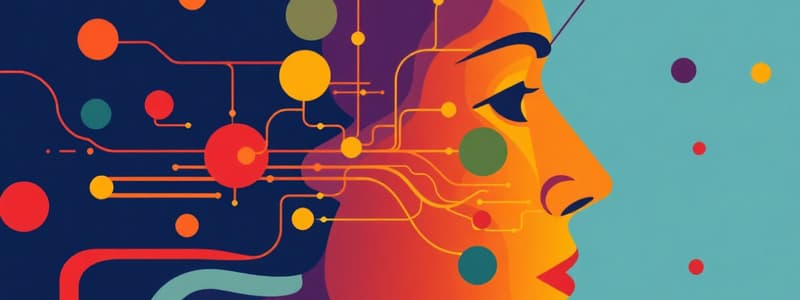Podcast
Questions and Answers
According to the provided content, what is the main process that is affected in the Stroop effect?
According to the provided content, what is the main process that is affected in the Stroop effect?
- Attentional bias towards emotional stimuli
- Feature integration of different stimuli
- Inhibition of irrelevant stimuli
- Interference from one information source to another (correct)
Based on the information provided, which of these statements about the Emotional Stroop Task is NOT correct?
Based on the information provided, which of these statements about the Emotional Stroop Task is NOT correct?
- The task primarily focuses on the impact of practice on attentional biases. (correct)
- The task involves naming the color of words that have varying emotional valence.
- It measures individual differences in attentional biases toward emotional stimuli.
- The task is used to examine how attention and processing of emotional stimuli differ.
Which stage of Treisman's Feature Integration Theory requires attention and is susceptible to illusory conjunctions?
Which stage of Treisman's Feature Integration Theory requires attention and is susceptible to illusory conjunctions?
- Cognitive stage
- Feature binding stage
- Attentive stage (correct)
- Pre-attentive stage
What is a key challenge related to the concept of attention?
What is a key challenge related to the concept of attention?
What is a main reason for the difficulty of simultaneously paying attention to two tasks?
What is a main reason for the difficulty of simultaneously paying attention to two tasks?
What is the primary function of the 'enhancing processing network' in attention control?
What is the primary function of the 'enhancing processing network' in attention control?
What is a consequence of limited attentional capacity in information processing?
What is a consequence of limited attentional capacity in information processing?
Which of these is NOT a direct implication of the provided content about the relationship between working memory and attention?
Which of these is NOT a direct implication of the provided content about the relationship between working memory and attention?
What is a primary function of attentional mechanisms?
What is a primary function of attentional mechanisms?
How does the concept of 'cognitive resources' relate to attention?
How does the concept of 'cognitive resources' relate to attention?
Which of the following is a primary focus of research related to the effects of limited attention?
Which of the following is a primary focus of research related to the effects of limited attention?
What does the dichotic listening task demonstrate about attention?
What does the dichotic listening task demonstrate about attention?
What is a conclusion drawn from Cherry's (1953) study on dichotic listening?
What is a conclusion drawn from Cherry's (1953) study on dichotic listening?
What is the primary focus of bottleneck theories of attention?
What is the primary focus of bottleneck theories of attention?
In the context of RSVP, what is the 'attentional blink'?
In the context of RSVP, what is the 'attentional blink'?
Which of these is NOT a factor that influences what stimulus is attended to?
Which of these is NOT a factor that influences what stimulus is attended to?
What is the main takeaway from the 'cocktail party effect' research?
What is the main takeaway from the 'cocktail party effect' research?
According to Treisman's attenuation theory, what happens to unattended messages?
According to Treisman's attenuation theory, what happens to unattended messages?
How does priming influence the recognition of stimuli?
How does priming influence the recognition of stimuli?
In the experiment by Vogel et al. (1998), what did the N400 component of the ERP indicate?
In the experiment by Vogel et al. (1998), what did the N400 component of the ERP indicate?
What is the primary difference between inattentional blindness and the attentional blink?
What is the primary difference between inattentional blindness and the attentional blink?
According to schema theory, how is unattended information processed?
According to schema theory, how is unattended information processed?
What is the primary goal of the 'attention hypothesis of automatization'?
What is the primary goal of the 'attention hypothesis of automatization'?
Which of these studies provides evidence for the existence of the 'attentional blink'?
Which of these studies provides evidence for the existence of the 'attentional blink'?
Which of these is NOT a key characteristic of the N400 event-related potential?
Which of these is NOT a key characteristic of the N400 event-related potential?
What is the main implication of the research on the 'attentional blink' and the N400 component?
What is the main implication of the research on the 'attentional blink' and the N400 component?
Which of these is considered a top-down influence on attentional allocation?
Which of these is considered a top-down influence on attentional allocation?
What is the primary difference between filter theory and attenuation theory?
What is the primary difference between filter theory and attenuation theory?
What type of information is processed during the 'semantic priming' effect?
What type of information is processed during the 'semantic priming' effect?
Flashcards
Attention
Attention
Actively processing specific information while ignoring other details.
Cognitive resources
Cognitive resources
Limits in mental capacity for processing information.
Sensory information selection
Sensory information selection
Choosing specific sensory inputs to focus on among many.
Working memory
Working memory
Signup and view all the flashcards
Dichotic listening task
Dichotic listening task
Signup and view all the flashcards
Attended vs. unattended stimuli
Attended vs. unattended stimuli
Signup and view all the flashcards
Unattended information processing
Unattended information processing
Signup and view all the flashcards
Temporal limitations of attention
Temporal limitations of attention
Signup and view all the flashcards
Stroop effect
Stroop effect
Signup and view all the flashcards
Emotional Stroop task
Emotional Stroop task
Signup and view all the flashcards
Feature integration theory
Feature integration theory
Signup and view all the flashcards
Inhibiting distractions
Inhibiting distractions
Signup and view all the flashcards
Networks controlling attention
Networks controlling attention
Signup and view all the flashcards
Rapid Visual Serial Presentation (RSVP)
Rapid Visual Serial Presentation (RSVP)
Signup and view all the flashcards
Attentional Blink
Attentional Blink
Signup and view all the flashcards
Bottleneck Theory
Bottleneck Theory
Signup and view all the flashcards
Filter Theory
Filter Theory
Signup and view all the flashcards
Cocktail Party Effect
Cocktail Party Effect
Signup and view all the flashcards
Treisman’s Attenuation Theory
Treisman’s Attenuation Theory
Signup and view all the flashcards
Threshold for Recognition
Threshold for Recognition
Signup and view all the flashcards
Priming
Priming
Signup and view all the flashcards
Semantic Priming
Semantic Priming
Signup and view all the flashcards
N400 Effect
N400 Effect
Signup and view all the flashcards
Inattentional Blindness
Inattentional Blindness
Signup and view all the flashcards
Attention Hypothesis of Automatization
Attention Hypothesis of Automatization
Signup and view all the flashcards
Schema Theory
Schema Theory
Signup and view all the flashcards
ERP (Event-Related Potential)
ERP (Event-Related Potential)
Signup and view all the flashcards
Semantic Processing during Attentional Blink
Semantic Processing during Attentional Blink
Signup and view all the flashcards
Study Notes
Attention and Information Processing
- Attention is a set of cognitive processes that allow for focused processing of specific information while diverting attention from other information.
- Various models exist, but separating attention from related cognitive processes like perception is difficult.
- Designing products and equipment must consider how people deploy attention and process information.
- Cognitive resources are limited. People are viewed as information processors with limited mental resources to devote to different incoming information (internal or external).
Selecting Sensory Information
- Sensory information is overwhelming.
- Attentional mechanisms select a subset, focusing on the information that needs to be acted on and passed to the next processing stage.
- Attention can also be viewed as controlling the transfer of information into working memory.
Limitations in Deploying Attention
- Limited mental resources constrain the simultaneous processing of multiple sources of information.
- Consequences of limited attention include how internal/external sources are processed.
- Processing can occur from stimuli/sources outside of actively attended stimuli.
Dichotic Listening Task
- Dichotic listening involves presenting different information to each ear simultaneously.
- The goal is to attend to one source (shadowing) and compare attended vs. unattended information regarding memory.
- Cherry (1953) found participants could identify physical aspects of unattended information (e.g., speech/noise, speaker gender) but couldn't report higher-order information, such as backward speech.
Are We Processing Unattended Stimuli?
- Participants only extract basic information from unattended stimuli, but lacking higher-level processing.
- Processing depends on where attention is directed.
Rapid Visual Serial Presentation (RSVP)
- Presents stimuli briefly (e.g., 100ms).
- Includes targets and distractors.
- Attentional blink: a processing deficit when T2 (target 2) follows T1 (target 1) within 200-500ms. T2 is less likely to be noticed or get processed if T1 is attended.
Theories of Attention
-
Bottleneck Theories: Propose that available information exceeds processing capacity, and that attention acts as a filter, allowing limited information through.
- Filter theory (Broadbent, 1958): Unattended messages are disregarded during initial processing (physical characteristics might be processed, but recognition/meaning is not addressed).
- This theory can explain some limited information processing in the Cherry (1953) study, but if the message is appropriately slow enough, more than one message can be processed.
-
Attenuation Theory (Treisman, 1960): Unattended messages are weakened (“reduced in volume”) but some semantic information is still available.
- Attenuated attention involves multiple analysis levels: physical, linguistic, and semantic.
- Key stimuli (e.g., name, fire alarm) have lowered processing threshold.
Factors Influencing Attention
- Cocktail Party Effect: Moray (1959) found that unattended information, like your name, can attract attention (i.e., disrupt shadowing).
- Switching Ears (Treisman, 1960): Demonstrated how meaning can modulate attention even if the stimulus is unattended.
Thresholds for Recognition
- Priming: Exposure to one stimulus affects subsequent response to another.
- The presence of a meaningful context can lower the threshold for processing a word.
- Semantic priming (e.g., dog -> cat).
Semantic Processing During the Attentional Blink
- Even if T2, presented during attentional blink, isn't consciously reported, it may still be processed semantically.
- ERP (electroencephalogram) measures electrical activity in the brain.
- The N400 component in the ERP waveform, reflects semantic processing that is affected by T1 which helps in decoding T2.
Schema Theory (Neisser, 1976)
- Unattended information is not acquired or processed due to cognitive biases.
- For example, if focusing on one movie, another superimposed movie may be missed.
Inattentional Blindness
- Failing to perceive an unattended stimulus or a change within that.
- Simons and Chabris (1999) demonstrated this by showing that people can miss an obvious stimulus that is not a target for attention.
Attentional Hypothesis of Automatization
- Attention is required while learning a task, with automatized tasks requiring less.
- The effort of the task influences the number of tasks that can be performed concurrently.
Attention and Perception
-
Feature Integration Theory (Treisman):
- Initially, features are perceived automatically (pre-attentive stage).
- Attention is needed to integrate the recognized features into a coherent stimulus.
- Illusory conjunctions can occur because attention is needed to correctly perceive an object's features.
-
Can be impacted by the number of distractors.
Inhibiting Distractions
- Attention involves top-down and bottom-up processes, including the recovery and focusing of attention.
- Mindfulness practice may improve sustained attention.
- Working memory capacity plays a role in filtering distractions.
Networks Controlling Attention
- Attention is governed by interconnected networks, each contributing to the focus and processing of stimuli.
- Mental resources are distributed to ensure that processing is focused on important incoming stimuli.
Studying That Suits You
Use AI to generate personalized quizzes and flashcards to suit your learning preferences.



